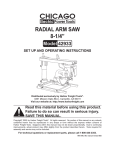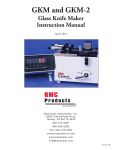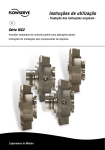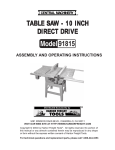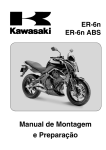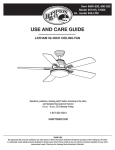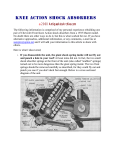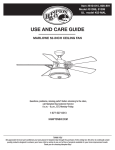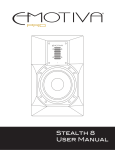Download Harbor Freight Tools 42933 User's Manual
Transcript
RADIAL ARM SAW 8-1/4 INCH 42933 ASSEMBLY AND OPERATING INSTRUCTIONS 3491 Mission Oaks Blvd., Camarillo, CA 93011 Visit our Web site at http://www.harborfreight.com Copyright© 2000 by Harbor Freight Tools®. All rights reserved. No portion of this manual or any artwork contained herein may be reproduced in any shape or form without the express written consent of Harbor Freight Tools. For technical questions and replacement parts, please call 1-800-444-3353. REV 11/04; 12/06 Specifications ITEM DESCRIPTION Power Requirements 120 VAC, 60 Hz, single phase 20.9 startup amps; 6.9 load amps; 1330 watts Motor 1-3/4 HP, 4200 spindle RPM, electric brake Saw Blade 8-1/4 (dia.) Arbor 5/8 inch Crosscut Distance 11 inches (maximum) Rip Cut Distance 20 inches (maximum) Depth of Cuts 45 degrees: 2 inches; 90 degrees: 2-1/8 inches Bevel Index Stops 0, 45, 90 degrees Mitre Index Stops Left and right: 0, 15, 30, 45, and 60 degrees Table Size 15-1/16 x 27-5/8 x 3/4 inches Accessories Saw Blade Replacement: Item # 43204 Save This Manual You will need the manual for the safety warnings and precautions, assembly instructions, operating and maintenance procedures, parts list and diagram. Keep your invoice with this manual. Write the invoice number on the inside of the front cover. Keep the manual and invoice in a safe and dry place for future reference. Safety Warnings and Precautions WARNING: When using tool, basic safety precautions should always be followed to reduce the risk of personal injury and damage to equipment. Read all instructions before using this tool! 1. Keep work area clean. Cluttered areas invite injuries. 2. Observe work area conditions. Do not use machines or power tools in damp or wet locations. Don’t expose to rain. Keep work area well lighted. Do not use electrically powered tools in the presence of flammable gases or liquids. 3. Keep children away. Children must never be allowed in the work area. Do not let them handle machines, tools, or extension cords. 4. Store idle equipment. When not in use, tools must be stored in a dry location to inhibit rust. Always lock up tools and keep out of reach of children. 5. Do not force tool. It will do the job better and more safely at the rate for which it was intended. Do not use inappropriate attachments in an attempt to exceed the tool capacity. SKU 42933 For replacement parts, please call 1-800-444-3353. Page 2 6. Use the right tool for the job. Do not attempt to force a small tool or attachment to do the work of a larger industrial tool. There are certain applications for which this tool was designed. Do not modify this tool and do not use this tool for a purpose for which it was not intended. 7. Dress properly. Do not wear loose clothing or jewelry as they can be caught in moving parts. Protective, electrically nonconductive clothes and nonskid footwear are recommended when working. Wear restrictive hair covering to contain long hair. 8. Use eye and ear protection. Always wear ANSI approved impact safety goggles. Wear a full face shield if you are producing metal filings or wood chips. Wear an ANSI approved dust mask or respirator when working around metal, wood, and chemical dusts and mists. 9. Do not overreach. Keep proper footing and balance at all times. Do not reach over or across running machines. 10. Maintain tools with care. Keep tools sharp and clean for better and safer performance. Follow instructions for lubricating and changing accessories. Inspect tool cords periodically and, if damaged, have them repaired by an authorized technician. The handles must be kept clean, dry, and free from oil and grease at all times. 11. Disconnect power. Unplug when not in use. 12. Remove adjusting keys and wrenches. Check that keys and adjusting wrenches are removed from the tool or machine work surface before plugging it in. 13. Avoid unintentional starting. Be sure the switch is in the Off position and locked when not in use, and before plugging in. Do not carry any tool with your finger on the trigger, whether it is plugged in or not. 14. Stay alert. Watch what you are doing, use common sense. Do not operate any tool when you are tired. 15. Take caution as some woods contain preservatives such as copper chromium arsenate (CCA) which can be toxic. When cutting these materials extra care should be taken to avoid inhalation and minimize skin contact. 16. Check for damaged parts. Before using any tool, any part that appears damaged should be carefully checked to determine that it will operate properly and perform its intended function. Check for alignment and binding of moving parts; any broken parts or mounting fixtures; and any other condition that may affect proper operation. Any part that is damaged should be properly repaired or replaced by a qualified technician. Do not use the tool if any switch does not turn On and Off properly. 17. Guard against electric shock. Prevent body contact with grounded surfaces such as pipes, radiators, ranges, and refrigerator enclosures. 18. Replacement parts and accessories. When servicing, use only identical replacement parts. Use of any other parts will void the warranty. Only use accessories intended for use with this tool. Approved accessories are available from Harbor Freight Tools. SKU 42933 For replacement parts, please call 1-800-444-3353. Page 3 19. Do not operate tool if under the influence of alcohol or drugs. Read warning labels on prescriptions to determine if your judgment or reflexes are impaired while taking drugs. If there is any doubt, do not operate the tool. 20. Use proper size and type extension cord. If an extension cord is required, it must be of the proper size and type to supply the correct current to the tool without heating up. Otherwise, the extension cord could melt and catch fire, or cause electrical damage to the tool. This tool requires use of an extension cord of 0 to 10 amps capability (up to 50 feet), with wire size rated at 18 AWG. Longer extension cords require larger size wire. If you are using the tool outdoors, use an extension cord rated for outdoor use (signified by “WA” on the jacket). 21. Maintenance. For your safety, service and maintenance should be performed regularly by a qualified technician. Safety Precautions When Using Radial Saws 1. Disconnect the line cord from the electrical outlet before servicing the Radial Arm Saw. 2. After cutting, wait until the saw blade comes to a complete stop before removing stock from the table, reaching around the saw blade, or leaving the area. 3. Never walk away and leave the saw running. 4. When making rip cuts, feed the stock into the blade against the direction of the blade rotation. 5. Always use a push stick when ripping small or thin stock. 6. Keep saw blade sharp and free of all rust and pitch. 7. Always use the anti-kickback finger attachment when making rip cuts. Feed stock from the opposite end from the anti-kickback finger attachment. 8. Always use the saw blade guides and fence, and never push stock being cut by hand. 9. Tighten and lock all adjusting (saw blade positioning) screws before operating. 10. Keeps hands out of the path of the saw blade during operation. 11. Only use 8-inch saw blades with 5/8 inch arbor on this machine. 12. Always secure the stock being cut with clamps whenever possible. 13. Make sure that the Switch is in the OFF position before plugging the line cord into the electrical outlet. 14. Many saw accidents are caused by dull, badly set, and improperly filed cutting blades; gum or resin adhering to the cutting blade; and by saw blade misalignment with the fence. Such conditions can cause the stock to stick, jam, stall the saw blade, or kick back at the operator. Never use carbide blades to cut anything other than wood; cutting hard materials can cause the carbide blade to shatter and break apart. SKU 42933 For replacement parts, please call 1-800-444-3353. Page 4 WARNING: Never attempt to free a stalled saw blade without first turning OFF the saw motor. 15. Provide proper support for the stock based on its size and the type of operation to be performed. 16. Avoid awkward hand positions (i.e., crossing arms during operation) in which a sudden slip could cause your hand to move into the moving saw blade. 17. Before making any adjustments to the Radial Arm Saw, the Switch should be in the OFF position and the Switch locked OFF. 18. Never turn the Radial Arm Saw ON before clearing the table and work surface of all objects (tools, scraps of wood, etc.), except the stock to be cut. 19. Always lock the carriage arm in place before lowering the saw blade. Otherwise, when the saw blade touches the stock, it may draw itself backward (with you) into the cutting area. 20. Never cut more than one piece of stock at a time, for any type of cut. 21. When cross cutting, always return the carriage arm to the rear position before letting go of the Handle. 22. Avoid Kickback of stock: - For rip cuts, the saw blade must be exactly parallel to the fence to prevent pinching or heeling. Use a stock separator on the output side of the stock cut. - Only feed the stock against the rotation of the saw blade. - Keep the stock firmly on the table while cutting. 23. When making rip cuts: - Push only on the main section of stock, between the saw blade and the fence. - Always use a push stick, never your hands. - Do not release the stock before the cut is complete, and push beyond the saw blade. - Always push the stock through the saw blade, never pull it through from the opposite direction. - Always use the anti-kickback claws. - Do not rip stock that is bowed, warped, or has nonparallel edges. 24. The use of abrasive, cut off, or wire wheels can be dangerous and is not recommended. Note: Performance of this tool may vary depending on variations in local line voltage. Extension cord usage may also affect tool performance. Warning: The warnings, cautions, and instructions discussed in this instruction manual cannot cover all possible conditions and situations that may occur. It must be understood by the operator that common sense and caution are factors which cannot be built into this product, but must be supplied by the operator. SKU 42933 For replacement parts, please call 1-800-444-3353. Page 5 Unpacking When unpacking, check to make sure that all the parts are included. Refer to the Parts List and Assembly Drawing at the end of this manual. If any parts are missing or broken, please call Harbor Freight Tools at the number on the cover of this manual as soon as possible. Installation During the assembly and installation procedure, you may have to refer to the Parts List and Assembly Drawings located at the end of this manual. 1. Secure the Radial Arm Saw to a solid bench top (or table) by bolting (or clamping) the saw frame down to the bench top. - The workbench must not be able to slide or tip over. Affix to floor if necessary. - Position the Radial Arm Saw (or saw and bench) to slope slightly to the rear so the radial arm carriage will not roll forward due to gravity. - The workbench should be of the appropriate length and width to allow the operator to stand aside of the saw blade, whatever position the saw blade is in. - The work area should have adequate, overhead, non-glare lighting. - Always lock the radial arm carriage before moving the unit. 2. Turn the Base (152) assembly upside down. Attach Table A (127) squarely to the Base assembly using the four cross-head Tapping Screws (165). 3. Attach the table stabilizer Stands to both sides of the Base using four Hex Nuts (82), Washers (149), and Round Head Bolts (148). 4. Place the Table and Base assembly on the workbench, right side up. Secure to the workbench with nuts, bolts, and washers (not supplied). 5. Position Table B (126) and Table C (125), and the rip fence (guide) and secure them by partially tightening the two screw clamps built into the Base assembly. 6. Set the Arm (118) assembly column into the Column Base. Move the Arm slightly to the left or right until the column index knob locks into the arm support column. The arm support column has nine positive stops: 0, 15, 30, 45, and 60 degrees (left and right). 7. Attach the Elevating Handle assembly to the Arm using the Allen wrench (provided). 8. Attach the Saw Blade (17) to the Gear Shaft (19) and secure with the Outside Flange (16) and Bolt (15). REV 03/01 SKU 42933 For replacement parts, please call 1-800-444-3353. Page 6 Lock the Gear Shaft with the Stopper Pin (22) located at the front part of the Gear Case Cover (26). Using a wrench, tighten the Bolt (15) over the Outside Flange (16), counterclockwise. 9. Place the Safety Guard (10) over the Saw Blade and tighten in place. 10. Install the anti-kickback pawl on the Safety Guard (10) with the pawls facing the rear of the machine. 11. Set the height by loosening its lock knob and moving it up or down. Retighten again when set to the proper height. 12. Verify that no play exists in the carriage, and that the arm, yoke, and bevel locks and clamps are tight. 13. Slip the Dust Guide (4) over the exhaust stem located on the Safety Guard. Operating Controls Elevating Handle (88) Yoke Pivot Clamp Handle (88) Switch (122) with Key (98) Safety Guard (10) Trigger Bevel Index Knob (74) Arm Index Knob (115) Bevel Lock Knob (71) Lock On Button Safety Guard Lock Knob (5) Anti-kickback Arm (13) Screw Clamp (137) ON / OFF Switch – The Switch has a built-in locking feature which requires a key to be inserted before the saw can be turned ON. Removing the Key and pushing the OFF button locks the saw against unintended use. For crosscutting, press the green Switch in, then squeeze and hold the Trigger. For rip cutting, press the SKU 42933 For replacement parts, please call 1-800-444-3353. Page 7 green Switch in, squeeze the Trigger (motor starts), then push up on the Lock On Button (for rip cutting only) to keep the motor running without holding the Trigger in. Depressing the Trigger again will release the Lock On Button, turning the motor off. Carriage Lock – The Carriage Lock Knob located on the left side of the Radial Arm, permits the saw assembly to be moved in or out, and locked at the desired position on the arm. It must be fully released for any crosscutting, and tightly locked for all operations in which the saw assembly is stationary. To lock turn clockwise. To unlock turn counterclockwise. Arm Angle – The Arm Index Knob (142) and Washer (140) are located at the Column Base (132). They can index, release, and secure the arm angle for various miter positions. Positive index stops are 0, 15, 30, 45, and 60 degrees (left and right). Non-index stops can also be set within the range of the arm assembly. Yoke Pivot- The Yoke Index Knob, located at the top of the Yoke (under the Carriage Arm) indexes the Yoke horizontally to 0 degree (crosscuts) or 90 degree (for rip cuts). Loosen the Yoke Pivot Clamp Handle and pull out the Yoke Index Knob. Turn the motor assembly until it locks at the index position. Lock the Yoke Pivot Clamp Handle. Blade Angle – The Bevel Index Knob (74) and the Bevel Lock Knob (71) are used to set the Blade angle (variable or indexed). Loosen the Bevel Index Knob (71). Turn the motor assembly clockwise or counterclockwise to the index notch of 0, 45, or 90 degrees, or to a variable position without using the index notch. Tighten the Bevel Lock Knob by turning clockwise. Depth of Cut – The Elevating Handle (100) at the rear of the arm is used to raise and lower the height of the Saw Blade. Turn the Elevating Handle clockwise to raise the Saw Blade or counterclockwise to lower it. Adjustments The following checks, and possible adjustments, should be done in the order listed before beginning operation. WARNING: For safety, unplug the line cord to the Radial Arm Saw. 1. Tables A (127), B (126), and C (125) are checked for straightness at the factory. SKU 42933 For replacement parts, please call 1-800-444-3353. Page 8 However, changes in humidity can slightly alter the condition of the wood. With the Screw Clamps (131) tightened, use a straight edge or framing square to check for flatness and squareness. Sand down any high spots using fine sandpaper. 2. Check for Arm tightness on the Column (132). If loose, tighten Bolt (115). 3. Check the crosscut travel of the Saw Blade for squareness. - Lock or tighten all adjustment levers and knobs. - Lower the Arm until it just clears the Table A front. - Place a framing square so it just touches a tooth of the Saw Blade. - Mark this location with a pencil on the table and draw a straight line using the square. - Check that the Saw blade follows this line from front to back. If the Saw Blade moves to the right or left side of the line as it travels the entire length of the Arm, loosen the Screw Clamps (137) and lightly tap on the Table left or right side until there is full travel alignment. Tighten the Screw Clamps again. 4. Check that the Saw Blade is square to Table A. - Place a framing square on Table A so that the square is flat on the Saw Blade (not touching teeth). - If there is no gap between the square and the Saw Blade, no adjustment is necessary. - If the square does not touch the Saw Blade evenly (with the square flat on the Table A), loosen the Bevel Lock Knob (71) and adjust the motor until the gap between Saw Blade and the square is eliminated. 5. Check that the Saw Blade is square to the rip fence. - Firmly place a framing square against the rip fence and the blade as shown to the right. The square should not touch any teeth. - If the square is not flush with the entire blade, loosen the yoke pivot Clamp Handle (66) and move the motor assembly until any gaps have been eliminated. Tighten the Yoke Pivot Clamp and recheck alignment. (This will simultaneously set both yoke indexing positions for in and out ripping.) Preparing the Work Table A In order to move the Saw Blade into different cutting positions, kerf marks (or grooves) must be cut into the worktable. It is recommended to cut grooves into a piece of 1/4 inch plywood mounted to the surface of Table A. 1. Cut a piece of 1/4 inch plywood the same size as Table A. 2. Mount the plywood to Table A using self-tapping, countersinking screws at the four corners of Table A. 3. Set the Carriage Arm at 0 degrees and lock in place. SKU 42933 For replacement parts, please call 1-800-444-3353. Page 9 4. Set the Saw Blade angle to 0 degrees index position (perpendicular to the worktable). 5. Draw out the Saw Blade to mid-range on the Carriage Arm and lock in that position. 6. Turn the Elevating Handle to lower the Saw Blade so it just touches the plywood top. 7. Place your hand on the Handle Assembly (87) and press the green ON button with the other hand. Squeeze the Trigger (86) to start the motor. 8. With the same hand that you turned ON the machine, loosen the Carriage Lock Knob and slowly move the Saw Blade back, cutting the rip fence; and then move it all the way forward, cutting a groove into the entire depth of the plywood. 9. With the machine still running, turn the Elevating Handle 1/4 turn, lowering the Saw Blade a little more. Pull the Handle back and forth again to cut the plywood groove a little deeper. Tighten the Carriage Lock Knob again. 10. With the machine still running, loosen the yoke Clamp Handle (66) and pull out the Yoke Index Knob and turn the yoke clockwise until it locks into the 90 degree. This cuts a swing line into the worktable for in-ripping. 11. Once the quarter turn (swing line cut) is complete, lock the yoke Clamp Handle. With the Saw Blade still turning, push on the Handle until the Saw Blade reaches the rip fence, cutting the rip trough in the center of the worktable. 12. Turn the machine OFF and return the Saw Blade to the crosscut position. Lock the Carriage Lock Knob. 13. Turn the machine ON and rotate the Yoke counterclockwise to the out-rip position. This cuts the swing line for out-ripping. Loosen the Carriage Lock Knob. 14. Lock the yoke Clamp Handle (66) and, with the Saw Blade revolving, push the Handle back until the new groove matches the groove cut in step 11. Turn the machine OFF. 15. Return the Saw Blade to the crosscut position. Unlock the Carriage Lock Knob (74b) and move the motor assembly to the rear position, behind the fence. Pull out the Bevel Index Knob (74) and lock the Saw Blade at index position 60 degrees. Turn on machine and pull the Handle forward. This will cut a kerf mark for bevel crosscuts. Turn the machine OFF. 16. Lock the Carriage Lock Knob and start the motor. Pull the Carriage Arm Index Lock Knob and move the Arm to the 45 degree right-hand miter position. This will cut a groove for miter cuts. Turn the machine OFF. SKU 42933 For replacement parts, please call 1-800-444-3353. Page 10 Operation WARNING: The Radial Arm Saw can be very dangerous and cause serious injuries if not operated properly. Review all safety precautions before operating. Always keep hands out of the path of the moving Saw Blade. Cross Cutting 1. Secure the stock to be cut against the table and fence. If the stock length is short, do not hold with your hand. Use a clamp to hold in place. 2. Adjust the Anti-kickback Arm (13) so it just clears the stock. 3. Check that the Pivot Yoke Clamp Lock and Bevel Index Knob are set to 0 degrees and are secure in place. 4. Adjust the Elevating Handle (100) so the Saw Blade (17) height is only 1/8 inch into the worktable. 5. Push the Handle backward so that the Saw Blade is in behind the stock to be cut. 6. Press the green Switch (122). Squeeze the Handle Trigger and slowly pull the Handle toward you, causing the Saw Blade to cut the stock. 7. When the cut is complete, release the Trigger and push the Handle all the way back. 8. Wait for the Saw Blade to stop turning before removing the stock. Mitre Cross Cutting 1. Loosen the yoke Clamp Handle (66) and pull out the Yoke Index Knob. 2. Turn the motor assembly to the left or right and lock the Yoke Index Knob at 45 degrees. 3. Tighten the yoke Clamp Handle (66). 4. Push the Handle backward so that the Saw Blade is in behind the stock to be cut. 5. Secure the stock to be cut against the table and fence. If the stock length is short, do not hold with your hand. Use a clamp to hold in place. 6. Adjust the Anti-kickback Arm (13) so it just clears the stock. 7. Press the green Switch (122). Depress and hold the Trigger in. Slowly pull the Handle toward you, causing the Saw Blade to cut the stock. 8. When the cut is complete, release the Trigger and push the Handle all the way back. 9. Wait for the Saw Blade to stop turning before removing the stock. SKU 42933 For replacement parts, please call 1-800-444-3353. Page 11 Bevel Cross Cutting 1. Loosen the Bevel Lock Knob (71) and pull out the Bevel Index Knob (74). 2. Turn the motor assembly clockwise or counterclockwise, selecting the desired angle (variable or indexed, i.e., 45 degrees). 3. Tighten the Bevel Lock Knob (71) and push in the Bevel Index Knob (74). 4. Push the Handle backward so that the Saw Blade is in behind the stock to be cut. 5. Secure the stock to be cut against the table and fence. If the stock length is short, do not hold with your hand. Use a clamp to hold in place. 6. Adjust the Anti-kickback Arm (15) so it just clears the stock. 7. Press the green Switch (122). Squeeze the Trigger and push the Handle all the way back. 8. When the cut is complete, release the Trigger and push the Handle all the way back. Compound Cross Cutting Compound crosscutting combines the mitre and bevel functions. Set the Saw Blade angles as previously described. Continue to follow steps 4 through 9, above. In-Rip Cutting Ripping is the process of cutting stock along the grain (or lengthwise). The stock if fed into the Saw Blade against the blade rotation (similar to a table saw). The fence is used as a guide to help maintain cutting width. 1. Loosen the yoke Clamp Handle (66) and pull out the Yoke Index Knob. 2. Turn the motor assembly to the left and lock the Yoke Index Knob at 90 degrees. 3. Tighten the yoke Clamp Handle (66). 4. Adjust the Saw Blade Safety Guard (7) so it is just above the surface of the stock to be ripped. 5. Adjust the Anti-kickback Arm (13) so it is just above the stock surface. 6. Adjust the Carriage Arm so that the Saw Blade is at the desired depth for the rip cut, and securely lock the Carriage Lock Knob in place. Note that the larger portion of the stock being ripped should be between the Fence and the Saw Blade. 7. Adjust the Elevating Handle (100) so that the Saw Blade is 1/16 inch into the worktable. 8. Verify that the Bevel Index Knob is locked into 0 degrees. SKU 42933 For replacement parts, please call 1-800-444-3353. Page 12 9. Slide the stock to be ripped into the cutting area and verify that it slides easily beneath the Safety Guard, Anti-kickback Arm, and (optional) Spreader Plate, and there is no wobble space. Remove stock from cutting area. 10. Press the green Switch (122), squeeze the handle Trigger (93) (motor starts), and push up on the Lock On Button. 11. From the side of the machine, feed the stock into the Saw Blade (against its rotation) using a (long) push stick. WARNING: Never use your hand to push the stock through the Saw Blade. Never reach around the Saw Blade while it is running. Serious injury can occur to hands and arms. 12. When the cut is complete, and before removing the stock, squeeze the Trigger or pull down on the Lock On Button, and press the red Switch. Out-Rip Cutting Out-ripping is done when the in-rip position will not permit a wide enough cut. This function moves the Saw Blade to the front of the machine. This operation is the same as in-rip cutting (previously described), with the exception that the Pivot Yoke is turned so that the Handle is on the right side of the machine (opposite of the in-rip position). 1. Adjust the Saw Blade for In-rip cutting as described on page 12. 2. Loosen the Bevel Lock Knob (71) and pull out the Bevel Index Knob (74). 3. Turn the motor assembly clockwise or counterclockwise, selecting the desired angle (variable or indexed, i.e., 45 degrees). 4. Tighten the Bevel Lock Knob (71) and push in the Bevel Index Knob (74). 5. Press the green Switch (122), squeeze the handle Trigger (motor starts), and push up on the Lock On Button. 6. From the side of the machine, feed the stock into the Saw Blade (against its rotation) using a (long) push stick. WARNING: Never use your hand to push the stock through the Saw Blade. Never reach around the Saw Blade while it is running. Serious injury can occur to hands and arms. 7. When the cut is complete, and before removing the stock, squeeze the Trigger or pull down on the Lock On Button, and press the red Switch. SKU 42933 For replacement parts, please call 1-800-444-3353. Page 13 Maintenance CAUTION: Before performing any maintenance, remove the Line Cord from the electrical outlet. 1. Yoke Tightness – Periodically check and tighten the yoke Clamp Handle (66). Over time this handle may become loose and not tighten entirely. To correct this condition, tighten the large Nut (64) at the base of the Handle using the 5/8 inch arbor wrench. 2. Cleaning – After each use, apply compressed air to blow clean all the parts of the Radial Arm Saw. 3. Saw Blades – Never use a replacement blade rated lower than 5,000 RPM, and larger than 8 inches diameter. 4. Motor Brushes – Inspect the two motor Brushes (55) after the first 50 hours of saw use. After that, check every 10 hours. Replace if necessary by a qualified technician. Improper Brush maintenance can cause motor failure. The Brush Caps (56) are located on each side of the motor housing. 5. Lubrication – The Radial Arm Saw does not require initial lubrication. Periodically, however, check all moving parts (i.e., knobs, levers, column shaft, Elevating Handle, shafts) to make sure that they move smoothly. If lubrication is required, use a small amount of light oil. Do not oil the Carriage Arm bearings because they are sealed and do not require lubrication. 6. Motor Preventative Maintenance – In addition to worn motor Brushes, the following are major causes of motor failure: - Using a dull or sticking Saw Blade - Feeding the stock through the Saw Blade too fast - Starting the cut before the Saw Blade has reached full speed - Abnormal friction caused by improper alignment of the motor assembly, especially when ripping - Low current or voltage supplied to the machine - Buildup of dust in the motor housing, which prevents proper cooling. SKU 42933 For replacement parts, please call 1-800-444-3353. Page 14 Troubleshooting PROBLEM CAUSE Arm is not per pendicular to the rip fence Too much play between the arm and column Saw will not make a square Yoke too loose when clamped to carriage crosscut or a good 60 degree mitre Dust between stock and rip fence cut. Table is not parallel with arm Rip Fence is not straight. Rear edge of table A not straight Saw Blade not per pendicular to worktable Too much play between arm and column Yoke is too loose when clamped to carriage 60 degree cut not accurate Bevel Lock Knob is loose Table is not parallel with arm Workpiece has a tendency to walk Saw Blade is not parallel with the fence. away from the fence when ripping Arm is not per pendicular to the rip fence. Dull Saw Blade Saw Blade tends to advance over Not pulling the Saw Blade properly the stock too fast Cut depth varies from one end to Too much play between the arm and column the other Dir ty tracts Saw does not travel smoothly in arm tracks Bad Bearings Elevating Handle slips when Screw loose on Elevating Handle elevating or lowering the Saw Blade Clamping knobs do not hold motor Treads stripped on knob(s) assembly to the set position(s) Saw Blade is leaning to one side Too much play between arm and column Yoke too loose when clamped to carriage Saw Blade bent or dull Saw Blade scores workpiece, not giving a good finished cut Not feeding saw properly Saw Blade or dado blades tend to push stock to one side when cross-cutting Saw Blade Stalls when ripping Motor will not reach full speed or power Motor overheats, stalls, trips the circuit breakers or fuses SKU 42933 Using improper Saw Blade for finish cut desired Saw Blade is heeling Too much play between arm and column Yoke too loose when clamped to carriage Rip fence not straight Dull Saw Blade Arbor Nut loose Dull Saw Blade Saw Blade not parallel to fence Faulty ON/OFF Switch Circuit overloaded with other appliances Motor windings burned out Circuit used is under rated for this application Overloaded motor Improper cooling caused by excessive sawdust accumulation around the motor Motor winding burned out or open Power source circuit breakers do not have sufficient power capacity SOLUTION Adjust the crosscut travel with the rip fence Tighten the column sleeve bolt Adjust Yoke clamp handle Clean worktable Adjust Table A Replace rip fence. Sand or replace Table A Adjust Saw Blade Tighten column sleeve bolt Adjust Yoke Clamp Handle Adjust Bevel Lock Knob Adjust Table A Adjust Saw Blade Adjust cross cut travel with rip fence Replace or shar pen blade Draw Saw Blade across stock with a slow and steady pull Tighten column sleeve bolt Clean tracts Replace Bearings Tighten Screw Replace knob(s) Adjust Saw Blade square to rip fence Tighten column sleeve bolt Adjust Yoke Clamp Handle Replace Saw Blade Draw the Saw Blade across stock with a slow and steady pull Replace Saw Blade Adjust Saw Blade square to the rip fence Tighten column sleeve bolt Adjust Yoke Clamp Handle Replace rip fence Replace or shar pen Saw Blade Tighten Replace or shar pen Adjust Saw Blade or fence to parallel Have the Switch unit checked by a qualified technician Use a different circult for the machine Replace motor Use a different circult with sufficient power for this machine Feed stock into Saw Blade more slowly Clean motor housing with compressed air Replace motor using a qualified technician Install proper size circuit breakers or change circuits to one with more capacity For replacement parts, please call 1-800-444-3353. Page 15 Parts List Part Description Q'ty Part Q'ty Part 1 Nameplate 1 57 Tilt Stop Bolt Description 1 110 Feed Screw Description Q'ty 2 Screw M5×8 2 58 Pressure Spring (2) 1 111 Cable 1 3 Washer 5 1 59 Handle Cover 1 112 Arm Base 1 4 Dust Guide 1 60 Tapping Screw St3.9×12 2 113 Washer 12 1 5 Yoke Index Knob 3 61 Tapping Screw St2.9×6.5 2 114 Pressure Spring (5) 2 69 62 Handle Cover 1 115 Bolt M12×60 1 1 63 Spring Pin 4×20 1 116 Buffer Piece 2 2 1 6 Nut M6 7 Guard Clamping Screw 8 Flexible Guard 1 64 Collet Nut 1 117 Nut M12 9 Label 1 65 Screw M5×8 1 118 Cable Cover 1 10 Safety Guard 1 66 Clamp Handle 1 119 Pressure Spring (5) 1 11 Guard Plate 1 67 Spring Board 2 120 Fixed Bolster 1 12 Spring Washer 5 1 68 Scale Label Board 1 121 Cable Binder 1 13 Anti-kickback Arm Ass'y 1 69 Dial Disc 1 122 Switch 1 14 Stud Bolt 1 70 Tapping Screw St4.8×16 6 123 Switch Case 1 15 Bolt M8×14(left) 1 71 Bevel Lock Knob 1 124 Key 1 16 Outside Flange 1 72 Pressure Spring (1) 1 125 Table A 1 17 Saw Blade 1 73 C-clip 1 126 Table B 1 18 Inside Flange 1 74a Bevel Lock Knob 1 127 Table C 1 19 Gear Shaft 1 74b Carriage Lock Knob 1 128 Guide Post Nut 1 20 Pressure Spring (1) 1 75 Knob Pin 1 129 C-clip 1 21 Retaining Ring 6 1 76 Bearing Shaft 4 130 Spring Pin 6×12 2 1 22 Stopper Pin 1 77 Bearing 60029 4 131 Column 23 Key B4×22 1 78 Stopper Shaft 1 132 Guide Rail 1 24 Tapping Screw St4.8×38 2 79 Thin Washer 16 2 133 Screw M5×10 1 25 Screw M5×20 1 80 Carriage 1 134 Spacer 1 26 Gear Case Cover 1 81 Spring Washer 8 8 135 Washer 4 2 27 Screw M4×8 2 82 Nut M8 8 136 Gauge 1 28 Bearing 80104 1 83 Washer 6 5 137 Screw Clamp 2 29 Stopper Washer 1 84 Fixed Spring Leaf 1 138 Column Clamping Washer 1 30 Output Gear 1 85 Hex. Head Bolt 1 139 Screw M5×12 1 31 Retaining Ring 20 1 86 Switch Baffle 1 140 Washer 12 1 32 Needle Bearing K101410 1 87 Handle A 1 141 Arm Lock Bolt M12×65 1 33 Wood Screw 5×70 2 88 Pressure Spring (4) 1 142 Arm Index Knob 1 34 Thin Washer 12 2 89 Cross Baffle 1 143 Pressure Spring (3) 1 35 Middle Shaft 1 90 Spacer 1 144 C-clip 1 36 Needle Bearing K121613 1 91 Pressure Spring (4) 1 145 Column Base 1 37 Middle Gear 1 92 Lock On Button 1 146 Table Clamp 2 38 Tapping Screw St4.8×32 4 93 Trigger 1 147 Bolt M8×14 4 39 Gear Case Cover 1 94 Screw M6×16 2 148 Round Head Bolt M8×16 4 40 Bearing 80102 2 95 Washer 6 2 149 Washer M8 4 41 Fan Guide 1 96 Spring Washer 6 2 150 Stand 2 42 Fan 1 97 Handle B 1 151 Fixed Base (Right) 43 Rotor 1 98 Screw M6×12 5 152 Base 1 44 Stator 1 99 Spring Washer 6 5 153 Fixed Base (Left) 1 45 Cable Coil 5 100 Elevating Handle 1 154 Round Head Bolt M6×16 4 46 Cable Clip 1 101 Arm Cap 1 165 Screw M6 x 16 4 47 Tapping Screw St3.5×9.5 1 102 Screw M4×12 2 166 Housing 1 48 Cable Cover 1 103 Collet Nut M14 1 167 Bushing 1 49 Tapping Screw St3.9×16 2 104 Washer 14 1 50 Screw M4×10 2 105 Cord Clamp 1 51 End Cap 1 106 Lead Wire 1 52 Grip Nut 1 107 Scale Label (Left) 1 53 Conical Collet Chuck 1 108 Arm 1 54 Brush Holder 2 108-1 Countersunk Flat Head Screw 8 55 Carbon Brush 2 108-2 Rail 2 56 Brush Cap 2 SKU 42933 109 Scale Label (Right) 1 1 For replacement parts, please call 1-800-444-3353. Page 16 Assembly Diagram (1-97) NOTE: Some parts are listed and shown for illustration purposes only and are not available individually as replacement parts. SKU 42933 For replacement parts, please call 1-800-444-3353. Page 17 Assembly Diagram SKU 42933 For replacement parts, please call 1-800-444-3353. Page 18 PLEASE READ THE FOLLOWING CAREFULLY THE MANUFACTURER AND/OR DISTRIBUTOR HAS PROVIDED THE PARTS DIAGRAM IN THIS MANUAL AS A REFERENCE TOOL ONLY. NEITHER THE MANUFACTURER NOR DISTRIBUTOR MAKES ANY REPRESENTATION OR WARRANTY OF ANY KIND TO THE BUYER THAT HE OR SHE IS QUALIFIED TO MAKE ANY REPAIRS TO THE PRODUCT OR THAT HE OR SHE IS QUALIFIED TO REPLACE ANY PARTS OF THE PRODUCT. IN FACT, THE MANUFACTURER AND/OR DISTRIBUTOR EXPRESSLY STATES THAT ALL REPAIRS AND PARTS REPLACEMENTS SHOULD BE UNDERTAKEN BY CERTIFIED AND LICENSED TECHNICIANS AND NOT BY THE BUYER. THE BUYER ASSUMES ALL RISK AND LIABILITY ARISING OUT OF HIS OR HER REPAIRS TO THE ORIGINAL PRODUCT OR REPLACEMENT PARTS THERETO, OR ARISING OUT OF HIS OR HER INSTALLATION OF REPLACEMENT PARTS THERETO. SKU 42933 For replacement parts, please call 1-800-444-3353. Page 19



















